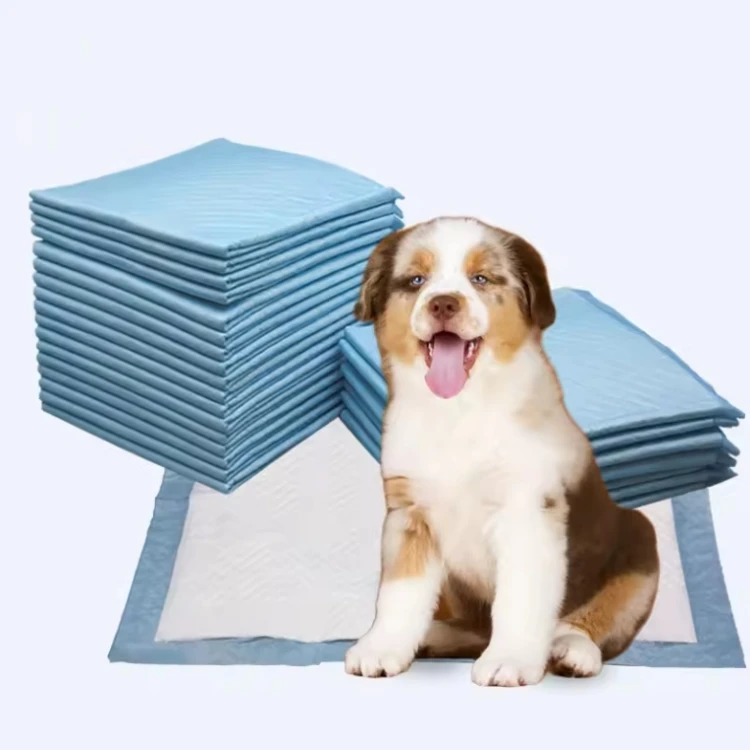Disposable pet training and pee pads have become an essential tool for many pet owners, providing a clean, convenient, and hygienic way to manage pet waste indoors. They are especially useful for puppies during house training, as well as for older dogs or pets with health issues that make outdoor trips challenging. This guide explores the features, benefits, and tips for effectively using disposable pet pee pads, with a focus on their usefulness for both dogs and their caregivers.
1. What are Disposable Pet Pee Pads?
Pet pee pads are absorbent mats designed to provide a designated spot for dogs to relieve themselves indoors. These pads typically have a layered structure that ensures liquid is absorbed quickly and prevents leakage, keeping floors clean and odor-free. The top layer is usually soft and quick-drying, the middle core absorbs and locks in moisture, and the bottom layer is leak-proof to protect surfaces.

2. Key Benefits of Using Pet Pee Pads
- Convenience: Pee pads offer a practical solution for pet owners living in apartments or in areas with harsh weather conditions, allowing pets to relieve themselves indoors without causing a mess.
- Effective House Training: For puppies, disposable training pads can serve as a consistent spot for relieving themselves, simplifying the house training process. The consistent use of a designated spot helps puppies develop good habits more quickly.
- Hygiene and Odor Control: Many pee pads are designed with odor control features, such as activated carbon or odor-neutralizing layers, which reduce unpleasant smells. This ensures that indoor environments remain fresh and clean.
- Suitable for Older Pets: Aging dogs or those with mobility issues may find it challenging to go outside frequently. Pee pads offer a comfortable and hygienic solution that meets their needs without putting strain on their joints.
3. Choosing the Right Pee Pad for Your Pet
When selecting a disposable pee pad, consider the following factors:
- Size: Pee pads come in various sizes, such as 28″x28″ or larger, to accommodate different breeds and needs. Larger dogs or those with a higher volume of waste may require more coverage to prevent spills.
- Absorbency Level: The level of absorbency varies among products. High-absorbency pads are ideal for larger dogs or for situations where frequent changes aren’t practical.
- Leak-Proof Design: Look for pads with a durable, leak-proof base to protect your flooring and maintain hygiene.
- Special Features: Some pads come with adhesive tabs to keep them in place, pheromone attractants to guide pets to the pad, or extra layers for increased durability and absorbency.
4. Tips for Using Pet Pee Pads Effectively
- Introduce the Pad Gradually: Guide your puppy or dog to the pad when it’s time to relieve themselves, using positive reinforcement to encourage proper use.
- Keep the Pad in a Consistent Location: Consistency helps pets understand where to go. Choose a spot that’s easy to access but not too close to feeding or sleeping areas.
- Dispose of Pads Regularly: Change soiled pads frequently to maintain cleanliness and prevent odors. This also helps reinforce proper habits, as pets prefer clean areas.
- Transitioning to Outdoor Training: If the ultimate goal is to train your dog to go outside, gradually move the pee pad closer to the door until your pet associates it with outdoor trips.
5. Environmental Considerations
While disposable pee pads offer convenience, it’s important to consider environmental impact. Opting for pads made from biodegradable materials or using reusable pads can help reduce waste, offering an eco-friendly alternative for conscientious pet owners.
6. Conclusion
Disposable pet training and pee pads simplify life for pet owners and provide a reliable indoor solution for dogs and puppies. From house training to caring for senior pets, these pads offer comfort, convenience, and effective waste management. By understanding how to choose and use these pads, you can enhance the well-being of both your pet and your household environment.
